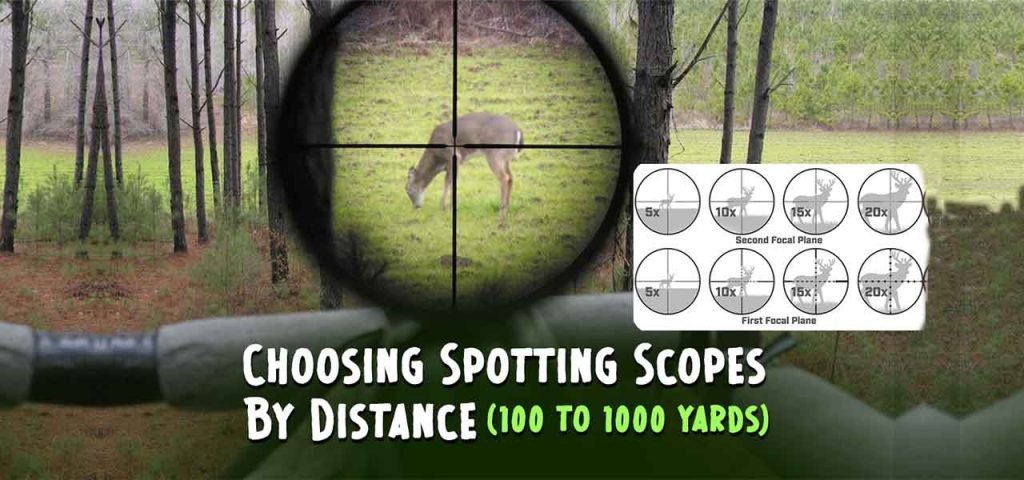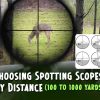Spotting scopes, with their precision and versatility, are essential for various outdoor activities. They serve bird watchers, hunters, and target shooters alike. However, with observation distances ranging from 100 to 1000 yards, choosing the right magnification level can be challenging. This comprehensive guide is designed to help you determine the most suitable power for your spotting scope based on your specific outdoor activities.
What is Spotting Scope Power, and how do you understand it?
A spotting scope is a device that magnifies distant objects and is commonly used for outdoor activities like birdwatching and hunting. Spotting scope power refers to how much closer an object appears when viewed through the spotting scope compared to how it appears to the naked eye. It is usually represented by a number followed by the symbol “x,” such as 20×60, 15-45×80, or more complex ones. For example, if a spotting scope has a 20x magnification, it means that the viewed object appears 20 times larger than it appears to the naked eye. Typically, Spotting scopes offer magnifications ranging from 15x to 60x. Choosing the correct magnification depends on the desired level of detail, as well as the practicality of the field of view and light conditions.

Relevant Article: How Far Can You See with a Spotting Scope?
However, it is essential to note that higher magnification does not always mean better image quality. The quality of the image viewed through a spotting scope depends on several factors, including the quality of the optics and the conditions in which you are using it.
To understand spotting scope power, you need to understand the different types of magnification. There are two types of magnification: fixed magnification and variable magnification. Fixed magnification is when the power of the spotting scope is fixed, and you cannot adjust it. On the other hand, variable magnification allows you to adjust the power of the spotting scope, giving you more flexibility in different viewing situations.
Spotting Scope Powers for Various Distances
What power spotting scope for 100 yards?
Ideal for bird watching or observing nearby wildlife, a scope with 20x to 30x magnification provides a wide field of view, making it easier to track moving objects.
What power spotting scope is for 200 yards away?
A magnification of 30x to 40x is suitable for general observation and target shooting. Benchrest shooters, who require detailed views of their target, might lean towards 40x for enhanced clarity.
What power spotting scope is for 300 yards and 400 yards?
Here, the balance between magnification and field of view becomes critical. Scopes with 40x to 50x magnification are best suited for these distances, providing enough detail while still allowing a comfortable viewing experience.
For 500 Yards and 600 Yards: power spotting scope I need
These distances require higher magnification to see details clearly. Scopes with 50x to 60x magnification are recommended, especially for activities like long-range target shooting or detailed wildlife observation.
What spotting scope power do I need for 1000 yards?
For extreme long-range observation, the highest available magnification, typically around 60x, is necessary. This level of magnification allows for the observation of fine details, essential for activities like advanced bird watching, long-range shooting, or even basic astronomical observation.
Considerations Beyond Distance
- Field of View: Higher magnification results in a narrower field of view. For activities requiring tracking of fast-moving objects, a wider field of view, offered by lower magnification, is advantageous.
- Light Gathering: Higher magnifications require more light to maintain image clarity. For low-light conditions, such as dawn or dusk observations, a lower magnification or a larger objective lens might be preferable.
- Image Stability: Higher magnifications can make image stability a challenge. Using a tripod with your spotting scope can significantly enhance the viewing experience, especially at higher magnifications.
The Role of Lens Quality and Coatings
The quality of the lenses and their coatings plays a crucial role in the performance of a spotting scope. High-quality lenses with advanced coatings can drastically improve image clarity and brightness, even at higher magnifications. Look for scopes with multi-coated or fully multi-coated lenses for the best results.
Spotting Scopes for Specialized Activities
- Bird Watching: Bird watchers often require a mix of moderate to high magnification and a wide field of view. Scopes with a range of 20x to 40x are generally preferred.
- Hunting: For hunters, ruggedness, and waterproofing, along with variable magnification (such as 20-60x), are essential to adapt to different terrains and distances.
- Astronomy: While not a substitute for a telescope, a spotting scope with high magnification (50x-60x) can be used for basic astronomical observations, like viewing the moon or larger planets.
Read Also:
Spotting Scopes vs. Telescopes- In details comparison
Comprehensive Guide to Long Range Spotting Scopes
Factors of Compact Spotting Scopes | Key Equipment
Durability and Portability
When buying a spotting scope, consider the build quality and portability. For outdoor activities, a durable, weather-resistant scope is vital. Additionally, a lighter and more compact model may be more suitable if you plan to travel or hike with your scope.
Conclusion
Selecting the right power for your spotting scope is integral to your outdoor viewing experience. Understanding the relationship between magnification, field of view, light conditions, and lens quality will help you make an informed choice. Whether you’re observing birds, hunting games, or engaging in precision shooting, the right spotting scope can immensely enhance your ability to see the world in greater detail.






